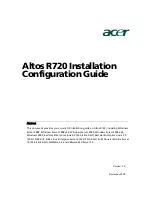
If the DHCP client has been activated, the automatically obtained parameters are
shown in the appropriate fields (IPv4 address, netmask, gateway).
You can specify up to three IPv6 addresses for your LANTIME timeserver.
Additionally you can switch off the IPv6 AUTOCONF feature. IPv6 addresses are
128 bits in length and written as a chain of 16 bit numbers in hexadecimal notation,
separated with colons. A sequence of zeros can be substituted with “::” once.
Examples:
"::" is the address, which simply consists of zeros
"::1" is the address, which only consists of zeros and a 1 as the
last bit. This is the so-called host local address of IPv6 and is
the equivalent to 127.0.0.1 in the IPv4 world
"fe80::0211:22FF:FE33:4455"
is a typical so-called link local address, because it uses
the “fe80” prefix.
In URLs the colon interferes with the port section, therefore IPv6-
IP-addresses are written in brackets in an URL.
("http://[1080::8:800:200C:417A]:80/" ; the last “:80” simply sets
the port to 80, the default http port)
If you enabled the IPv6 protocol, the LANTIME always gets a link local address in
the format “fe80:: ….”, which is based upon the MAC address of the interface. If a
IPv6 router advertiser is available in your network and if you enabled the IPv6
AUTOCONF feature, your LANTIME will be set up with up to three link global
addresses automatically.
The next parameter in this sub section is “Netlink mode”. This controls the port speed
and duplex mode of the selected Ethernet port. Under normal circumstances, you
should leave the default setting (“autosensing”) untouched, until your network
administrator tells you to change it.
The standard moniker for this technology is IEEE 802.3ad, although it is known by
the common names of trunking, port trunking, teaming and link aggregation. The
conventional use of bonding under Linux is an implementation of this link
aggregation. Only one link is used at any given time. At least two physical Ethernet
ports must be linked to one bonding group to activate this feature. The first Ethernet
Port in one bonding group provides the IP-Address and the net mask of this new
virtual device. The implementation of the LANTIME Bonding feature will not
replace the MAC address of the active ethernet port. Depending on the LINK state of
the ETH-port the IP address of the first port in the bonding group will be set to the
next ethernet port. All services will be restarted automatically.
At this menu point it is possible to add each Ethernet port to a bonding group. At least
two physical Ethernet ports must be linked to one bonding group to activate this
feature. The first Ethernet Port in one bonding group provides the IP Address and the
net mask of this new virtual device.
102
Содержание M900
Страница 1: ...Technical Information Operating Instructions M900 GPS PZF Redundant SHS ...
Страница 21: ...Assembly with CN UB E 21 ...
Страница 48: ...48 ...
Страница 64: ...Configuration Ethernet 64 ...
Страница 69: ...Configuration Notification 69 ...
Страница 74: ...Configuration Security 74 ...
Страница 87: ...Configuration Local 87 ...
Страница 95: ...Configuration Statistics 95 ...
Страница 144: ...IRIG Standard Format 144 ...
Страница 145: ...AFNOR Standard Format 145 ...
















































